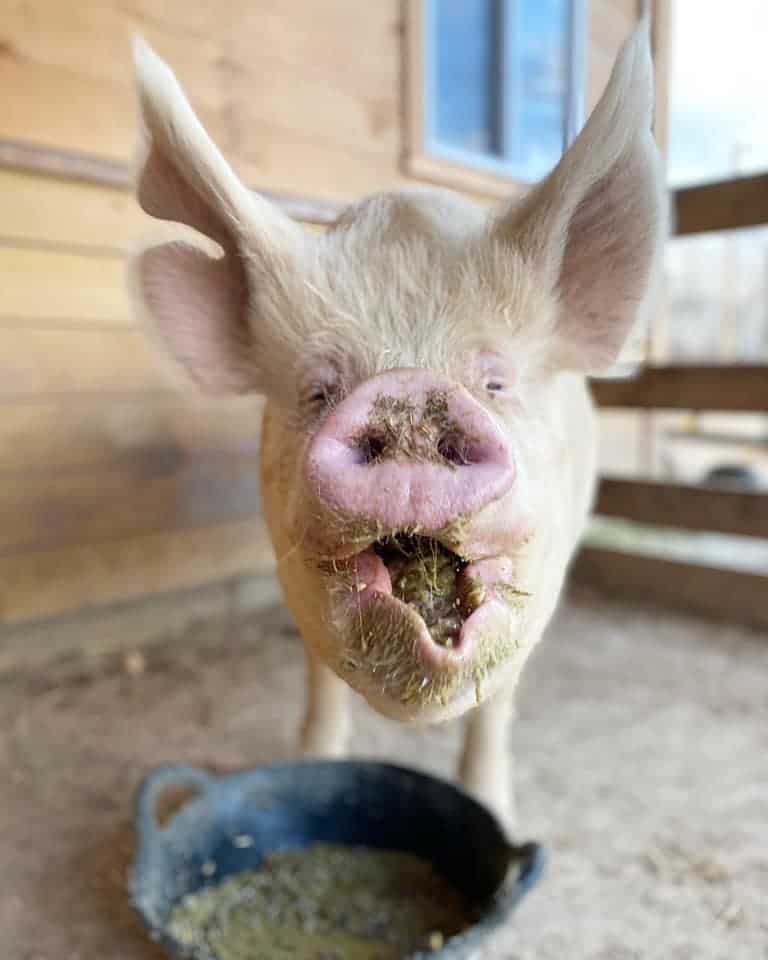
This resource was updated in preparation for veterinary review. It was originally published on June 17, 2021.

Veterinary Review Initiative
This resource has been reviewed for accuracy and clarity by a qualified Doctor of Veterinary Medicine with farmed animalA species or specific breed of animal that is raised by humans for the use of their bodies or what comes from their bodies. sanctuary experience as of January 2025.
Check out more information on our Veterinary Review Initiative here!
The compassionate lifelong care of pigs at animal sanctuaries starts with the food they’re provided. While obesity can be an issue for any pig, large breedDomesticated animal breeds that have been selectively bred by humans to grow as large as possible, as quickly as possible, to the detriment of their health. pigs and potbellied pigs are especially prone to easy weight gain and a host of obesity-related health issues. Because of this, maintaining your pig residents at a healthy weight is an integral part of compassionate care. While pigs are all individuals who have their own preferences and needs, there are some general principles to consider regarding their physiology and nutritional needs. Unfortunately, when it comes to large breed pigs, most of the available nutrition information focuses on industry recommendations aimed at productivity and profitability, so it can be difficult to know exactly what diet is best for their long-term well-being. In this resource, we’ll talk about the components of a healthy diet for mature pig residents (both large breed and mini pigsThe term “mini pig” is used to categorize smaller breeds of pigs, such as Potbellies, Julianas, and Kunekunes, and to differentiate between these breeds and large breed pigs, such as Yorkshires, Landrace, or Hampshires, who are sometimes referred to as “farm pigs”. The descriptor “mini” can be a bit misleading- some breeds of mini pigs can weigh over 200 pounds! Terms like “teacup”, “micro”, “pocket”, “nano”, and “micro mini” are deceptive terms that are sometimes used to intentionally mislead people into thinking an individual pig will remain a certain size.).
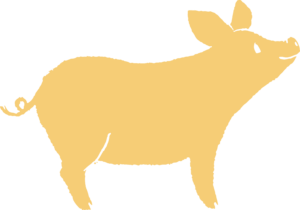
Piglets Have Their Own Dietary Needs!
For more information about feeding piglets, check out our resource here.
Daily Food For Pigs
Pigs are foragers, and free-living pigs spend a good portion of their day traveling in search of food. When they are not foraging, they are typically resting. When foraging is not necessary (or possible), pigs are often less active and spend a larger portion of their day at rest than they otherwise would. Given their propensity for weight gain, finding ways to encourage activity, in addition to providing an appropriate diet, is important. Therefore, in addition to considering what to feed your pig residents, it’s also important to think about how to feed them.
A pig’s diet should consist of a complete diet pig food (we’re going to call these “pig pellets” throughout this resource, though they don’t necessarily have to be in a pelleted form), as well as forage and supplemental produce. Because of their love of eating and their propensity for weight gain, pig residents must have their portions managed to ensure they maintain a healthy weight.
Pig Pellets
Part of your residents’ diet should consist of measured amounts of pig pellets. Whether you are feeding large breed pigs or mini pigs, we do not recommend using commercial pig food designed for large breed pigs (typically called “hog,” “swine,” or “farm pig” food), as these are not designed with the pigs’ best interest and needs in mind and are instead formulated to encourage rapid growth and weight gain. While each manufacturer has a different formula, these pellets are typically higher in protein (and sometimes fat) and are significantly lower in fiber than what is ideal for sanctuary pig residents. Commercial large breed pig pellets are intended to be fed in large quantities, often on a free-choice basis. Because rapid growth and weight gain are the ultimate goals, manufacturers don’t want the pigs to fill up on fiber, as they will end up eating less. In a compassionate care setting, where the individual’s well-being is the focus, it’s important to balance a restricted diet not only with adequate nutrient intake, but also with a feeling of being satiated, so a higher fiber diet is recommended.
When considering the best formula for sanctuary pig residents, a high-quality mini pigThe term “mini pig” is used to categorize smaller breeds of pigs, such as Potbellies, Julianas, and Kunekunes, and to differentiate between these breeds and large breed pigs, such as Yorkshires, Landrace, or Hampshires, who are sometimes referred to as “farm pigs”. The descriptor “mini” can be a bit misleading- some breeds of mini pigs can weigh over 200 pounds! Terms like “teacup”, “micro”, “pocket”, “nano”, and “micro mini” are deceptive terms that are sometimes used to intentionally mislead people into thinking an individual pig will remain a certain size. food or a custom recipe are your best options. These can be offered dry or soaked in water to soften.
Custom Recipes
If you can, having a custom food milled is a great option, especially if you care for large breed pigs, but this may not be practical for everyone. To ensure you are feeding the best food for your residents, we recommend working with a nutritionist and also getting your soil and water tested to determine what minerals, and in what quantities, should be added to the food. There are a few sanctuaries that use their own custom pellet with great success and that have shared their recipes with other sanctuaries in the past. Because these formulas have been designed specifically for the sanctuary’s residents, if you decide to use a custom recipe from another sanctuary or pig caregiverSomeone who provides daily care, specifically for animal residents at an animal sanctuary, shelter, or rescue., we recommend working with your veterinarian or an experienced nutritionist to assess the nutritional content and adapt the recipe as needed to best meet the needs of your residents (based on soil and water testing, as well as the specific needs of your residents). As an added bonus, when using a custom recipe, you can talk to a nutritionist or your veterinarian about additions to support hoof health or address other concerns you may have.
Consider The Quantity
One major challenge that often arises when pursuing a custom pig pellet is that most mills have a minimum batch size requirement that is often too large to be practical for many sanctuaries. What this minimum size is varies by mill. When looking into having your own food milled, consider whether or not you have the physical means to store it properly (which may require having a large grain hopper), and also consider if you will go through the food before it begins to degrade or spoil. Going through the effort to provide a custom pellet and then storing the food improperly or using it past its recommended shelf life will not only negate the benefits of providing a custom recipe, it could also lead to health challenges that could have been avoided.
Commercial Mini Pig Food
Unlike the commercial options available for large breed pigs, when it comes to mini pigs, there are multiple high-quality commercial pellets available designed with the individual’s well-being in mind. Given this fact, if the individuals in your care are mini pigs, using a high-quality commercial formula might make more sense than looking into a custom recipe, but if you care for a large number of residents, or have specific dietary concerns you are trying to address, you might opt for a custom pellet instead.
If you care for large breed pigs and find that using a custom pellet is not possible, using a high-quality mini pig pellet is a good option. Two brands that are often recommended by folks in the sanctuary community, both for large breed pigs and mini pigs, are Ross Mill Farm’s Champion Potbellied Pig Food and Mazuri Mini Pig Food (which offers different formulas based on the individual’s stage of life). There are other brands that offer comparable nutrition, so be sure to explore the options in your area.
Comparison Of Popular Pig Pellet Formulas
Below is a look at the protein, fat, and fiber content of a few popular mini pig formulas as well as a sample custom recipe that is used by multiple sanctuaries and was designed with a nutritionist as well as experienced veterinarians. While protein, fat, and fiber are not the only important nutrients in a pig’s diet, these are the levels that are often quite different from a commercial food designed for large breed pigs and can help you evaluate other mini pig food brands. Please keep in mind that recipes may change over time, so it’s good practice to look at the current nutritional analysis for any food you are considering.
| Protein | Fat | Fiber | |
| Mazuri Mature Maintenance | Min. 12% | Min. 4% | 9-13% |
| Ross Mill Farm’s Champion Pig Food | 14% | 2% | 13% |
| Custom Recipe | Min. 12% | Min. 2.5% | Max. 16% |
Suggestions For Pig Pellet Storage
In addition to feeding a high-quality food formula, you must be sure to store the food properly to ensure your residents reap all the nutritional benefits. Food will keep best if kept in a cool, dry, dark place. All food, including unopened bags, should be stored in tightly sealed metal cans or bins to prevent rodents from getting into food. If the recommended shelf life is not indicated on the food’s label, you can contact the manufacturer for this information, but be aware that the shelf life will be impacted by storage conditions. Storing food too long or in undesirable conditions can not only lead to rancid or moldy food but can also cause food to become depleted of vitamins and minerals. You should never feed rancid or moldy food to pigs as it can make them very sick.
Forage
In addition to feeding quality pig pellets, pig residents should have access to forage. Supplementing your pig residents’ diet with grass hay and opportunities to forage can not only allow you to feed them smaller portions of pellets while keeping them satiated, but it also honors who they are as foragers.
Pasture/ Woodland Vegetation
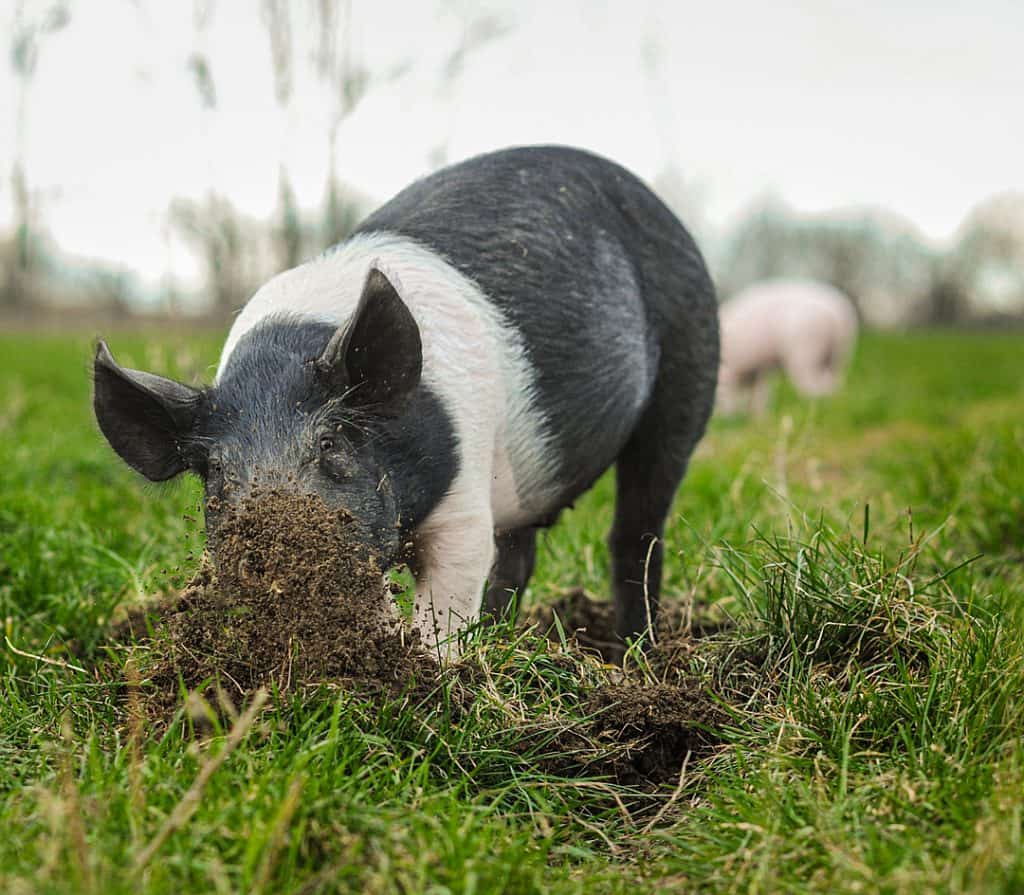
Whenever possible, it’s important to design outdoor spaces for your pig residents that offer foraging, grazing, and rooting opportunities, though we recognize that outdoor spaces and foraging opportunities will be impacted by your regional climate. While offering foraging opportunities is important because it is a natural pig behavior, providing healthy residents with ample foraging opportunities in a large, varied space has the added benefit of increasing activity levels. Activity, along with an appropriate diet, is key to preventing obesity. If possible, offering a mix of pasture and woods is ideal.
Grass offers a high-fiber addition to a pig resident’s diet which can help keep them satiated and promote a healthy digestive system. Pigs can tear up a pasture quickly, so it’s important to provide them with enough space so they don’t decimate the pasture and turn it into a mud pit. While pigs may avoid certain plants that are toxic to them, there’s also a chance that they will not, so be sure to remove those from their living spaces to eliminate the risk of ingestion. Depending on the make-up of your pasture’s vegetation, you may find that the plants your residents don’t like start to take over the pasture. Reseeding annually may be necessary.
The amount of forage available to your residents will affect the amount of pig pellets they require. Sanctuaries in climates where foraging opportunities vary greatly by season may find that they can reduce pellet portions when vegetation is plentiful – in some cases reducing the pellet portion size by 50%.
Grass Hay
Like fresh grass, grass hay offers a good source of fiber. Some sanctuaries feed grass hay to their pig residents year-round, while others offer it only during times when they do not have access to fresh grass or other vegetation. Be sure to offer a grass versus legume hay – legume hays are not a good choice because they are often lower in fiber and higher in calories, protein, and calcium than grass hay. Timothy or Bermuda grass hay is a better choice. Be sure to remove and replace hay if it becomes wet or soiled.
Supplemental Produce
Supplementing your pig residents’ diet with fresh produce will not only keep things interesting for residents, but by offering high-fiber and low-calorie veggies, you can help make them feel more satiated. Pigs can eat some starchy vegetables, but these should be fed in moderation. While they can eat fruit, it’s best to limit foods that are high in sugar, so fruit is best thought of as a treat offered in smaller quantities than something like leafy greens.
Keep Toxicity In Mind!
Be aware that for some of the foods listed below, certain parts of the plant are toxic. This is especially important to keep in mind with pigs because planting pig-safe foods in their pasture can be a fun form of enrichment, but not all the foods that are safe to include in a pig’s diet are safe to be incorporated in this way. A good example is kale – while the leaves are a great addition to a pig resident’s diet, the seeds and roots are toxic. Check out our list of toxic and questionable foods here.
Foods to consider incorporating into your pig residents’ diet include:
- Leafy greens such as lettuces (not iceberg), Swiss chard, kale, spinach, or bok choy
- Cucumbers
- Summer squash varieties such as zucchini or yellow squash
- Winter squash varieties such as butternut or pumpkin (canned pumpkin puree is also a good option)
- Cooked sweet potatoes
- Snow peas
- Beets
- Carrots
- Bell pepper
- Tomatoes
- Cauliflower and broccoli (some prefer cooked)
- Apple (Apple seeds contain amygdalin. Generally, large quantities would be needed to cause serious toxicity, but the amount depends on the size and weight of the individual. Seeds can be removed if you are concerned – especially if you are caring for very small pigs.)
- Melons
- Stone fruits – stone removed
- Cherries – pit removed
- Grapes
- Bananas (peel does not need to be removed)
Beware Of Canned Vegetables
While providing fresh fruits and veggies may not always be feasible, be aware that canned vegetables tend to contain higher levels of sodium, making them an unhealthy option. Due to pigs’ sensitivity to salt poisoning, excess salt should be avoided, so always pay attention to sodium levels when feeding packaged foods. Frozen veggies are typically a healthier choice than most canned varieties.
Supplements For Pigs
While complete nutrition pig pellets are formulated to have all the nutrients a pig needs, some sanctuaries have found that additional supplements help keep their residents healthy. We recommend working with your veterinarian or nutritionist to identify specific supplements to include in your residents’ diet and in what quantity. Haphazardly supplementing with certain nutrients can result in unintended consequences, including potential toxicity. Some supplements that sanctuaries and pig caregivers have found beneficial include:
- Biotin for hoof and skin health
- Glucosamine (or glucosamine/ chondroitin combination) to soothe joint inflammation and slow cartilage deterioration
- Vitamin E (sometimes in combination with selenium) for general health and to combat deficiency which can cause a host of health issues
- Omega 3 Fatty Acids (such as in the form of flaxseedWhen using flaxseed as an animal supplement, it should be ground, not served whole. Consider using a clean coffee grinder and grinding the seed right before feeding for greatest effectiveness! meal, flaxseed oil, or hemp seed oil) for hoof and skin health as well as other health benefits
- Probiotics for gastrointestinal and immune system health
- Turmeric for its anti-inflammatory properties and other health benefits
Putting It All Together – How Much To Feed Pigs
The amount of food each individual pig should eat will vary based on their size, metabolism, and activity level, as well as the make-up of their diet. Keep in mind that when talking about diets for pigs, it is not just their pellet portion that needs to be managed. Consider all aspects of their diet when determining appropriate portion sizes (including how much vegetation they have access to in their outdoor space).
While the ideal food amount will vary between individuals, sanctuaries have had success feeding groups of pig residents together by providing ample space for everyone to spread out. However, some individuals may need to be separated for meals to ensure they get their full share without being bullied away from their food or to prevent someone from eating more than their mealtime allowance. Be sure to monitor everyone’s weight and body condition, as well as feeding time social dynamics when determining the best feeding arrangements.
Unfinished Meals
A healthy pig who is fed an appropriate amount should consistently finish all of the food offered to them. Unfinished meals are cause for close observation and further investigation. In some cases, food left behind is your clue that you are overfeeding your residents (though if this happens when a new food is introduced, it may be that they simply don’t like it). If forage availability changes seasonally, you may find that what is an appropriate portion size when forage is sparse becomes too much when ample forage is available, resulting in residents no longer finishing their meals (and indicating portion sizes should be adjusted). Other times, food left behind is a clue that someone is not feeling well and requires close monitoring or veterinary attention. Contact your veterinarian right away if one of your residents is uninterested in food, does not finish their meal and shows other signs of concern, or appears excited to eat but does not actually do so.
Sample Large Breed Pig Diets
To help give you a starting point, we gathered examples of daily meal plans from experienced sanctuaries and pig caregivers. The amounts below reflect the amount of food fed per day – not per meal.
Example A
8 cups Custom Pig Pellets and 3 cups fresh produce plus supplements and unlimited grass hay
Example B
8-16 cups Ross Mill Farm’s Champion Potbellied Pig Food (amount depends on whether or not pigs have access to pasture) plus approximately 8 cups high-fiber, low-calorie produce and supplements. During the summer months, produce portions are reduced.
Example C
4-16 cups Custom Pig Pellets (within this wide range the average amount for most residents is 8 cups) plus 1 cup raw hulled sunflower seeds (for healthy fats for hoof health) and supplements. When pasture is not available, each resident gets 2 flakes of grass hay. Fresh produce is provided 1-2 times weekly.
Sample Mini Pig Diets
If you search for feeding recommendations for mini pigs, you may think that, unlike large breed pigs, there is a set amount that should be fed to minis (many sources suggest 1-2% of their ideal body weight, but some recommend as high as 3%). In fact, some food manufacturers recommend a specific pellet amount based on the individual’s size. While this may be a good starting point, just like with large breed pigs, the appropriate amount of food for each individual will depend on not just their size, but also their activity level, metabolism, and overall health, as well as the make-up of their diet.
The Myth Of The Teacup Pig
Never underfeed a growing mini pig resident in an attempt to keep them small (this is different from adjusting an overweight individual’s diet to try to encourage them to lose weight). This will only lead to a malnourished, starving individual and is detrimental to their health. While this is unacceptable for any pig, it’s especially important to point out for mini pigs because this dangerous practice is sometimes recommended to folks caring for young mini pigs by people perpetuating the myth of the teacup or micro pig. At The Open Sanctuary Project, unacceptable means that we cannot condone (or condone through omission) a certain practice, standard, or policy. See a more detailed explanation here.
Here are some examples of a typical diet for mini pigs (per day, not per meal):
Example A
1-2 cups Ross Mill Farm’s Champion Potbellied Pig Food plus fresh produce and supplements. Residents get grass hay when pasture is not available.
Example B
1.5- 2 cups Mazuri Mini Pig Food plus 2 heads romaine lettuce and 2 cups produce. Unlimited Timothy hay.
Example C
⅔- 2 cups Ross Mill Farm’s Champion Potbellied Pig Food plus 2 cups lower calorie veggies, tofu, and supplements.
How Many Meals Should Pigs Eat Each Day?
Because wild pigs naturally eat multiple small meals per day, most sources recommend splitting their daily ration into at least two meals. However, pigs who have access to ample foraging opportunities in their outdoor living spaceThe indoor or outdoor area where an animal resident lives, eats, and rests. can eat as they choose throughout the day, similar to the behaviors of free-living pigs. Because of this, some sanctuaries only offer their residents one meal of pig pellets per day when forage is available. Sometimes the residents make this decision before the caregivers do, opting to stay out foraging rather than showing up at mealtime. In other cases, caregivers make the change to feeding once per day to encourage their residents to spend more time foraging (which some individuals may not do if they know a meal will be brought to them). Adjusting the number of meals fed per day based on forage availability is a common practice with large breed pigs, and all of the pig caregivers we talked to feed once per day when forage is plentiful. This practice appears to be less common with mini pigs – while some caregivers adjust their meal frequency based on forage availability, others continue to feed their mini pig residents twice daily. Every pig and every situation is different, so find what works best for your residents. Just make sure they have enough appropriate forage available to them to accommodate this adjustment. If you have not reseeded your pasture recently, and it’s become overrun with the vegetation your residents avoid eating each year, their pasture may look like it has plenty of forage available, but your residents may disagree. Also take into consideration a resident’s overall health and mobility – some individuals may struggle to forage, despite the availability.
Feeding Supplies
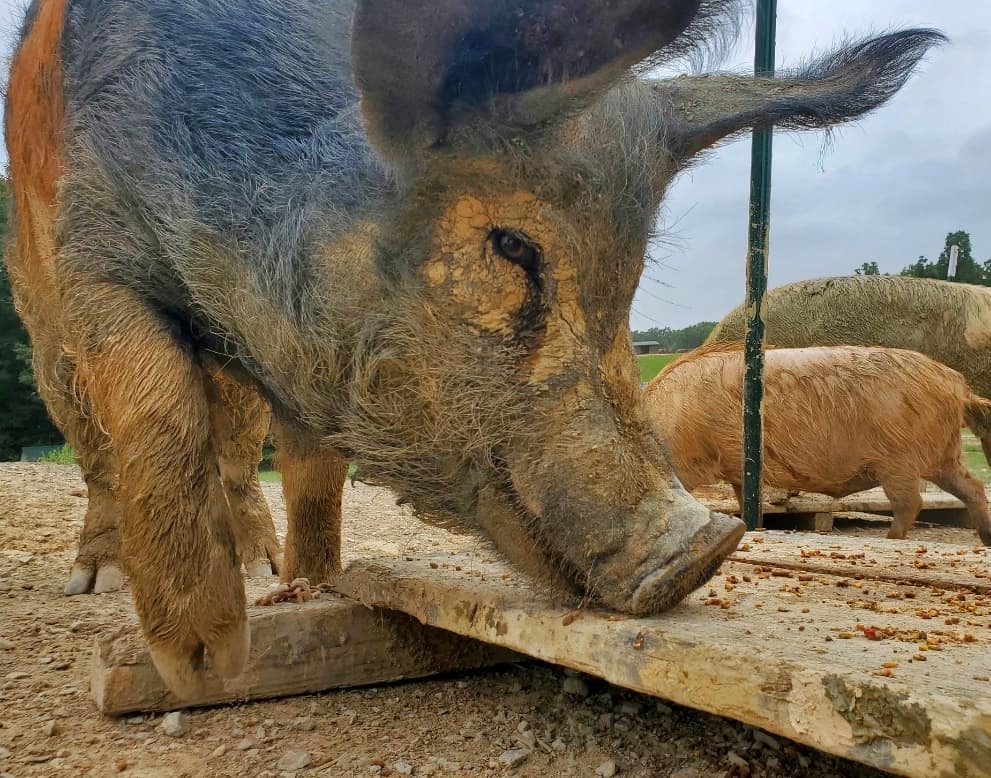
When considering what to feed pigs out of or off of, be sure to think about cleanliness and foot health. Some sanctuaries that used metal troughs in the past found that these posed a safety issue as residents moved them around and banged them up (due to sharp, broken pieces of metal). Heavy-duty rubber bowls are a safer option, though clean-up may be a bit tedious if you care for a large number of pigs. Some sanctuaries have made their own feeding troughs or feeding platforms instead. Just avoid anything with sharp or abrasive edges that could result in injury and make sure the materials can safely withstand the feeding process.
If feeding out of bowls, be sure to offer at least one bowl per resident, and if you are using a trough or platform, determine how many pigs can comfortably eat from each and offer enough to accommodate everyone. To prevent anyone from getting pushed away from food, we recommend spreading the food out and offering a few additional feeding stations (think musical chairs but with a couple of extra chairs so no one ever loses).
Water For Pigs
Beware Of Salt Poisoning!
Keep in mind that while water is important for all residents, pigs are the most vulnerable to developing salt poisoning (this is actually the most common form of poisoning in pigs and is usually caused by water deprivation). Prevention is key, so make sure residents always have a reliable source of water and have systems in place for water sources to be checked frequently throughout the day. If an individual is getting up less often or drinking less due to another health challenge, be sure to offer them water regularly. You can read more about salt poisoning here.
Like every sanctuary resident, pigs require a clean, freely accessible water supply. However, keeping pig resident waters clean and full can be a bit more challenging than it is for other residents. Pigs are notorious for getting into water tubs if it’s warm out, and even if that’s not physically possible, it only takes one dunk of a muddy resident’s snout to turn sparkling clean water into a murky mess. Another challenge is that pigs may use that strong nose of theirs to move and flip water bowls or tubs, which is both messy and can also leave them without drinking water. It’s important to keep all this in mind when figuring out how to best provide water to your pig residents.
Pigs can go through a lot of water, so you’ll either need a plan to regularly refill their water throughout the day, or you’ll need a water source that refills automatically. And if you are in an area where water sources are likely to freeze, you’ll need to account for this as well.
Auto Waterers
If you can install automatic water units, this can be a good way to ensure constant access to fresh drinking water. However, some units hold up better with pigs than others. Pigs are strong and can easily bend or break flimsy water units, so it’s best to go with something heavy-duty (one favorite is Nelson brand). Farm Sanctuary recommends mounting automatic water units to a concrete pad.
Another benefit of an automatic waterer is that there are models available that have enclosed heat sources and thermostats that can ensure water doesn’t freeze over in cold weather. If you go this route, be sure to keep fire safety in mind. Pigs absolutely must not have access to the heating element or any wires. Be aware that some designs are such that when the unit is opened for cleaning, the heating element becomes exposed, and these units may also be easily opened by a curious pig resident.
Water Tubs
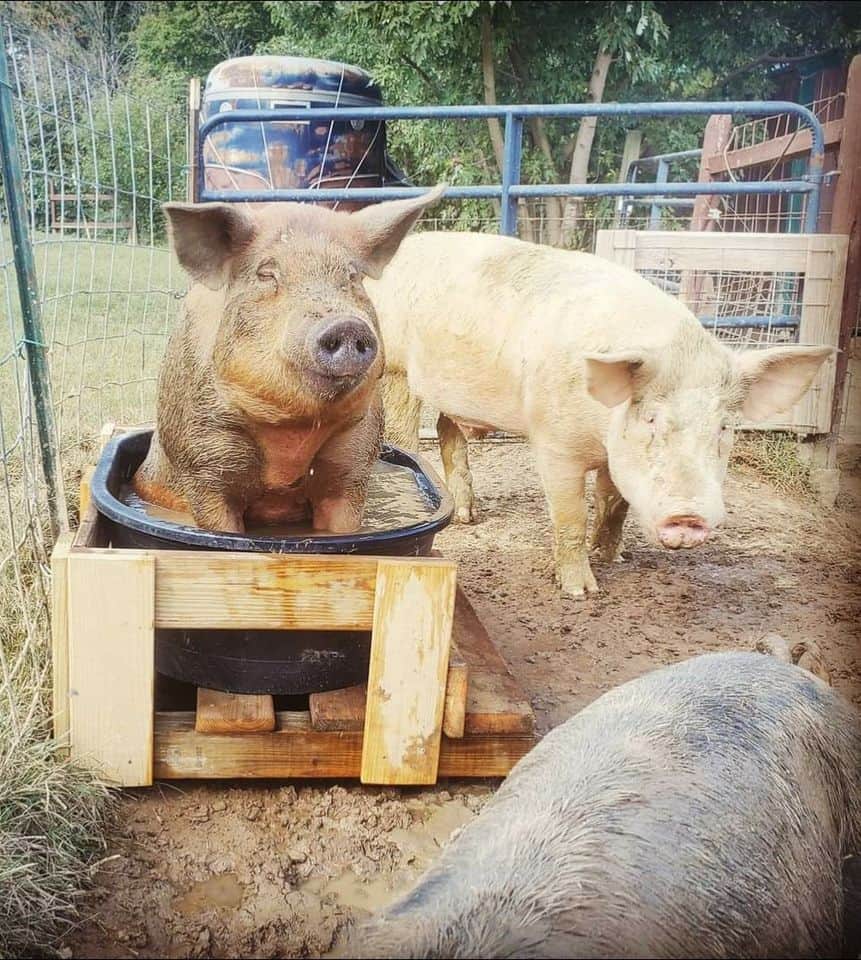
Another option for a constant source of fresh water is to use a water tub with a float hooked up to a hose. As the water level drops, the float valve releases more water from the hose, keeping the tub full at all times. This setup might work better for some of your other large mammalian residents than it does for pigs since there is a good chance your pig residents will decide to hop right in when the weather gets warm, and you will likely have to protect the float from being knocked out of place (resulting in the tub overflowing) or knocked off the tub entirely (resulting in the hose continually flowing, soaking the ground, but not actually filling the tub). The tub and float will need to remain fairly level to prevent overflowing. Building a platform and/or frame to keep the tub level and securely in place may be beneficial (but make sure you can still easily empty and clean it!). Alternatively, you can use a tub without a float and plan to fill it regularly throughout the day.
Drinker Water Tub
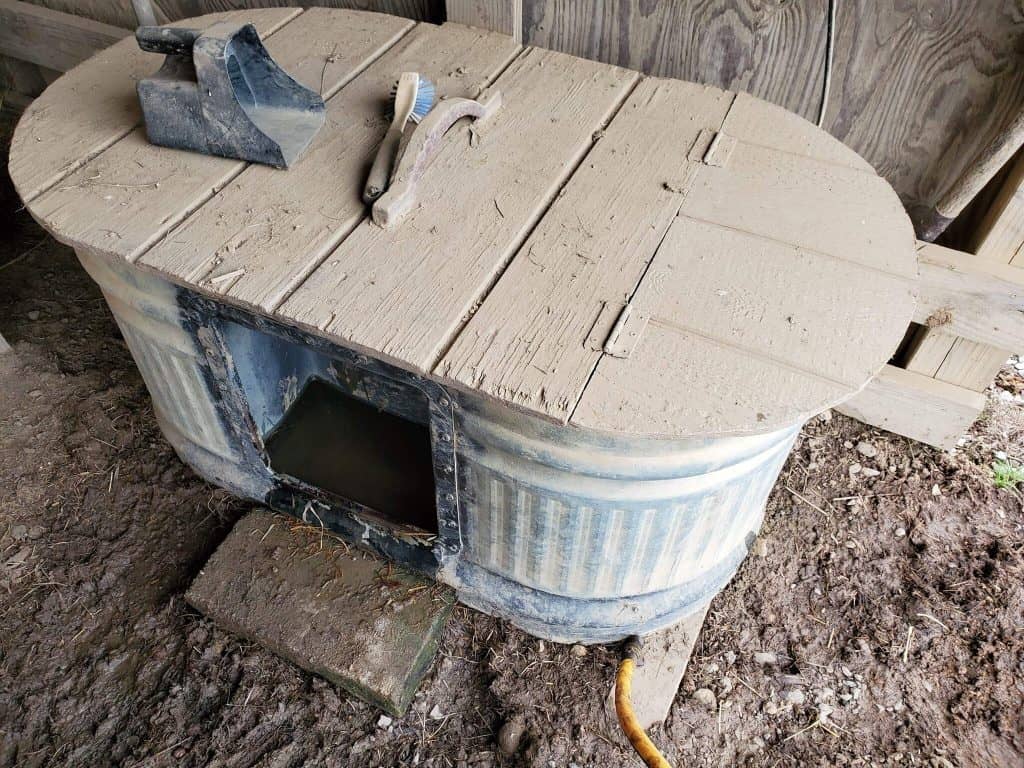
One challenge with water tubs for pigs is that for residents to comfortably access the water, the tub must be rather shallow compared to what you might offer to other large mammals. Offering a water tub with a “drinker” unit allows you to use a much larger tub (and therefore, provide more water) while still ensuring your residents can comfortably drink. Instead of drinking from the top of the tub, residents drink from a recessed space in the front of the unit, and the remainder of the tub acts as a holding tank for fresh water. A built-in float keeps this area filled with accessible drinking water, and you can even build a wooden cover to help keep the water in the tub clean (as shown above). The drinker can be cleaned and flushed out with a powerful hose as it becomes dirty. One challenge with this type of water unit is that it must be on a level surface or the water will overflow the drinker. Building a base to place it on can help keep it level.
Bowls And Buckets
If you only need to provide water to one or two residents, a bucket or large rubber bowl may suffice, so long as you can keep it filled at all times. Much like when providing a water tub, bowls and buckets are likely to be spilled or flipped by pig residents. Building a wooden frame to secure the bowl or bucket in place can help prevent this from happening.
Warm Weather Considerations
During warmer weather, we recommend providing at least some drinking water in vessels that prevent residents from getting into them. If residents do not have access to mud wallows or ponds, you should offer additional water sources for them to get into to cool off. While you can’t stop them from drinking these additional water sources, and these will still need to be cleaned regularly, by providing a separate water source that can stay cleaner, longer, you will ensure residents have access to clean drinking water, even if they decide to drink muddy pool water instead.
Food Recommendations For Older Pigs
Some older pigs may continue to thrive on the standard pig diet you provide, but others may benefit from (or even require) certain modifications. To read more about diet recommendations for older pigs, in addition to other care considerations, check out our resource here.
Article Acknowledgements
This resource could not have been created without the shared knowledge of compassionate pig advocates including Afton Hughes, Happily Ever Esther Farm Sanctuary, Woodstock Farm Sanctuary, and Jill Tedeschi, Healthy Herd Consulting.
SOURCES:
Feeding And Nutrition Of Potbellied Pigs | Merck Veterinary Manual
Pig Nutrition | Pig Advocates League
What To Feed A Potbellied Pig | Best Friends
Basic Miniature Pig Care | Lafeber
Selecting Hay For Your Horse | Lori K. Warren, PhD, PAS
Pig Info | Pigs Peace Sanctuary
Pig Appropriate Foods | Mini Pig Info
Foods That Are Known To Be Potentially Toxic To Pigs | Mini Pig Info
Toxic Foods And Plants | American Mini Pig Association
Glucosamine And Chondroitin For Osteoarthritis Pain | Arthritis Foundation
Potbellied Pigs- Senior Care | Arizona Exotic Animal Hospital
Dietary Fiber And Intestinal Health Of Monogastric Animals | Rajesh Jha, Janelle M. Fouhse, Utsav P. Tiwari, Linge Li, Benjamin P. Willing (Non-Compassionate Source)
Healthy Foods | American Mini Pig Association (Non-Compassionate Source)
Supplements For Pigs | American Mini Pig Association (Non-Compassionate Source)
Non-Compassionate Source?
If a source includes the (Non-Compassionate Source) tag, it means that we do not endorse that particular source’s views about animals, even if some of their insights are valuable from a care perspective. See a more detailed explanation here.








